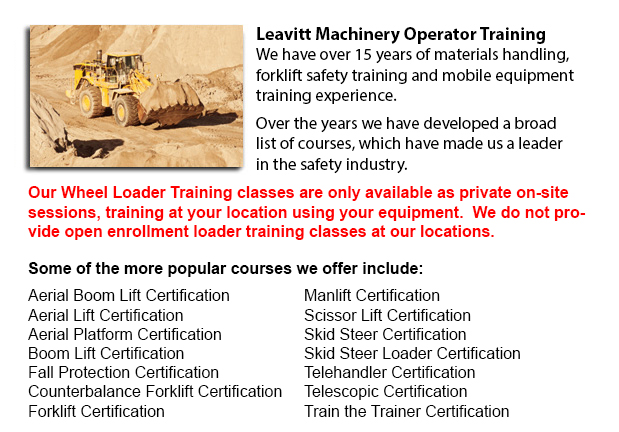
Hamilton Wheel Loader Operator Training - In order to pick up considerable cargo, industrial cranes utilize pulleys and levers. Before, Romans used cranes in order to erect large monuments making the origin of these equipment at least two thousand years ago. Several Medieval churches utilized cranes in their construction and the Egyptian people might have used them when constructing the pyramids.
The new kind of a crane can be either simple or complex, and cranes vary based on their application. Mobile cranes, for example are somewhat simple. A telescopic boom or steel truss mounts its movable platform. A system of pulleys or levers raises the boom and there is often a hook suspended. These cranes are frequently designed for demolition or earthmoving by changing the hook out with another piece of device like for instance a bucket or wrecking ball. Telescopic cranes have a series of hydraulic tubes that fit together to form the boom. These units can likewise be mobile.
Regular wheels, or specialized wheels used for a caterpillar track or railroad track enable these mobile booms to be able to navigate unpaved and uneven surfaces.
Rough terrain and truck mounted cranes are mobile also. Outriggers are positioned on the truck mounted model in order to increase stability, while rough terrain cranes have a base which tends to resemble the bottom of a 4-wheel drive. These cranes are equipped to work on rough ground making them best in the construction industry for example.
Most often used on railroads and in ports, the Gantry crane can transport and unload large containers off ships and trains. Their bases include massive crossbeams which run on rails so as to lift containers from one location to another. A portainer is a special kind of gantry which transports supplies onto and off of ships in particular.
Floating cranes are mounted on pontoons or barges and are another essential piece of machinery important to the shipping industry. Since they are located in water, they are designed for a variety of services consisting of port construction, building bridges and salvaging ships. Floating cranes are capable of handling very heavy cargo and containers and like portainers, they could even unload ships.
Loader cranes have hydraulic driven booms that are fitted onto trailers to load supplies onto a trailer. The jointed parts of the boom could be folded down when the equipment is not in being utilized. This particular kind of crane can be likewise considered telescopic in view of the fact that one section of the boom could telescope for more versatility.
Usually used in automated warehouses, stacker cranes tend to follow an automatic retrieval system and can operate utilizing a remote. These cranes are outfitted together with a forklift equipment and can be seen in huge automated freezers, obtaining or stacking foodstuff. Using this type of system allows personnel to remain out of that freezing setting.
Tower cranes, normally the tallest type, typically do not have a movable base. They need to be assembled piece by piece. Their base is similar to a long ladder with the boom at a 90 degree angle to the base. These cranes specialize in the construction of tall buildings and are often connected to the inside of the building itself throughout the construction period.
-
Hamilton Aerial Platform Training
Hamilton Aerial Platform Training - Aerial hoists are able to accommodate various odd jobs involving high and hard reaching spaces. Often utilized to perform routine repair in structures with high ceilings, prune tree branches, hoist heavy shelving u... More -
Hamilton Heavy Equipment Operator Certification
Hamilton Heavy Equipment Operator Certification - The heavy equipment operator is a person who manipulates the controls and drives different kinds of big machinery. Heavy machinery is most commonly utilized on construction sites to deliver supplies t... More -
Hamilton Scissor Lift Ticket
Hamilton Scissor Lift Ticket - Scissor lifts have greatly benefited construction operations in view of the fact that the job that used to require much effort and lots of people, can now be completed utilizing the scissor lift truck and only one indiv... More -
Hamilton Forklift Certification Courses
Hamilton Forklift Certification Courses - Forklift certification courses really help to make sure that businesses utilizing forklifts, comply with the regional and local rules. The drivers of the forklift should undergo forklift certification prior t... More -
Hamilton Forklift Training Program
Hamilton Forklift Training Program - The forklift is a common powered industrial vehicle which is in wide use these days. They are occasionally called jitneys, hi los or lift trucks. A departments store would use the forklift to unload and load merch... More -
Hamilton Forklift License
Hamilton Forklift License - Obtaining a forklift license or forklift certification in North America would require the trainee to do hands-on training in addition to classroom instruction. The state, provincial and federal regulatory bodies are respon... More -
Hamilton Manlift Operator Certification
Hamilton Manlift Operator Certification - Our aerial lift and scissor platform training and certification empowers participants with a general understanding and knowledge of the efficient and safe use of "Power Operated Mobile Work Platforms," under... More -
Hamilton Forklift Operator Certification
Hamilton Forklift Operator Certification - Forklift operator certification is usually needed for employees working in industrial, warehouse or construction setting to guarantee the safe utilization of forklifts. Workplace training has to follow a met... More

Forklift Certification Hamilton
TOLL FREE: 1-888-254-6157
Hamilton, Ontario
forkliftcertificationhamilton.com
Email Us
About Us


